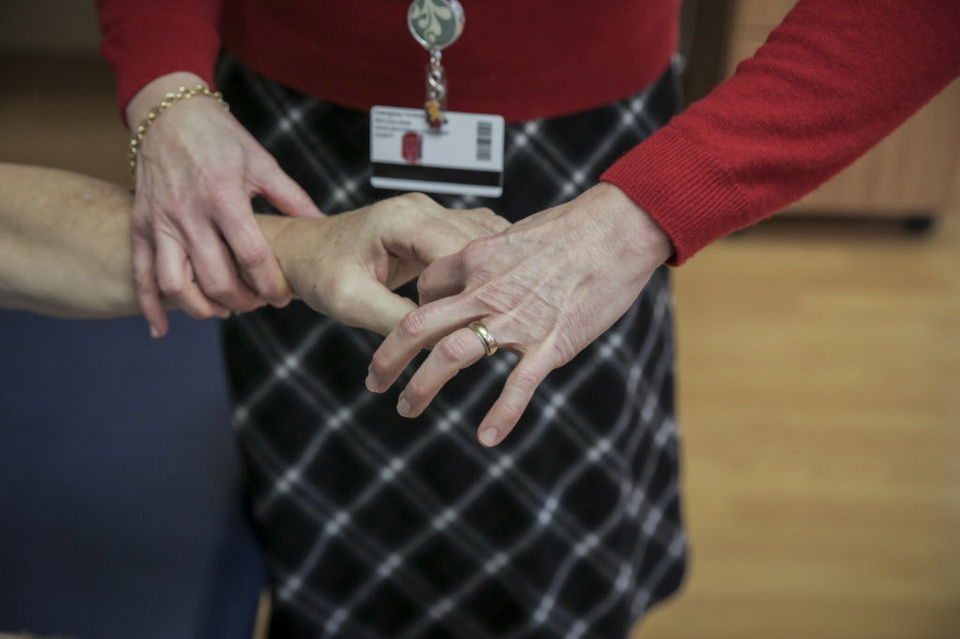By Tom Hallman Jr.
The Oregonian, Portland, Ore.
Molly Hoeflich’s heart problem showed up decades ago, during a routine physical when she was an 18-year-old college student.
Listening through a stethoscope, the doctor said he could hear a heart murmur, a distinctive sound produced when blood flow through the heart is turbulent.
“He told me it was no big deal,” Hoeflich said recently. “It was like a doctor telling someone they had flat feet.”
After college, Hoeflich went on to medical school, a career that eventually landed her as medical director of in-patient rehabilitation at Portland Providence Medical Center.
But at age 56, Hoeflich started noticing occasional heart palpitations. She figured they were from stress, but as a precaution she underwent a physical. Her doctor used an echocardiogram, an ultrasound that uses sound waves to create a video to see how her heart was functioning.
“As so often happens in medicine, we were looking at one problem and found another,” Hoeflich said. “The palpitations weren’t the issue, it was something bigger.”
The doctor called Hoeflich at home and told her she had moderate aortic valve stenosis. The disease, the most common heart ailment, occurs when the aortic valve, located between the heart’s left ventricle and the aorta, narrows, making the heart work harder to carry blood throughout the body.
“I saw a cardiologist and more tests were run,” Hoeflich said. “I thought it was something to watch, and I’d come back in a year. When I came back in a year, he was much more somber. He suggested I see a heart surgeon.”
Hoeflich put it off. “I didn’t want to go,” she said. “If I did, it would make the problem I had real.”
Hoeflich asked the cardiologist when she might need surgery.
“He said one to 10 years,” she said. “And like every patient, I focused in on the 10, because I did not want surgery.”
But within the year, Hoeflich was experiencing problems.
“If I was walking up a short hill, I’d be out of breath,” she said. “On the flat, I was fine. I was a fast walker and was all over the hospital. But with even a gentle incline I was huffing, puffing and slowing down. How could this be me?”
She ignored the symptoms. But her husband, also a physician, was acutely aware of what was going on. He told her to schedule another appointment with the cardiologist, and he went with her.
“My cardiologist was clear. I had to have surgery,” Hoeflich said. “I tried to put it off. I work with people who have surgeries, so I knew about surgical complications.”
At 57, she considered herself healthy. She exercised and was in good shape. But a part of her body was betraying her. A heart valve was getting narrower, which caused the heart to work harder. When that happens, a person can go into heart failure.
The cardiologist was adamant: It was time. She met with Dr. Eric Kirker, a cardiac surgeon. They knew each other from the hospital, and he spoke bluntly.
“Once you get symptomatic,” he said, “you need to have it fixed. Statistics show that if nothing is done, 50 percent of the people who have it will die within 18 months.
buy cialis strips online blackmenheal.org/wp-content/themes/twentytwentytwo/inc/patterns/en/cialis-strips.html no prescription
”
The surgery, which took place in 2010, was considered routine.
“This is a very common heart surgery,” Kirker said. “With someone her age, we put in a mechanical valve. Biological valves are great, but one wouldn’t last the rest of her life. It would wear out, and she’d need another surgery.”
Though the surgery was routine, not so the recovery.
“No way around it,” Kirker said. “It’s tortuous, and it beats you up.”
Hoeflich said she didn’t anticipate “how lousy” she’d feel, with nausea and weakness. “I felt I wasn’t getting better,” she said, “but my husband drew a graph for me to show me that my perception was wrong. I came back to work eight weeks after surgery.”
The experience, she said, has helped her with her job working with men and women who are rehabilitating from strokes, amputations and spinal cord injuries.
“I deal with a lot of things,” she said. “But with my surgery, I learned the challenge that comes with a new physical impairment. I have a disabled daughter and I understand about having a disabled person in my life. But this, even though it was transient, gave me a deeper appreciation of what that’s like.”
Hoeflich says she’s a different doctor now.
“Not better,” she said, “just different. I think I might listen a little more closely to my patients. They don’t always do what I want them to do. Maybe now I am a little easier in understanding the reasons for that. But I still have a job to do to help them, so there are times when I have to be hard on a person to help them get better.”
With the surgery four years behind her, Hoeflich said, she rarely thinks about her heart.
But she says she was given a gift: “Without that surgery, I’d be dead.”














































































































































































































































































































































































